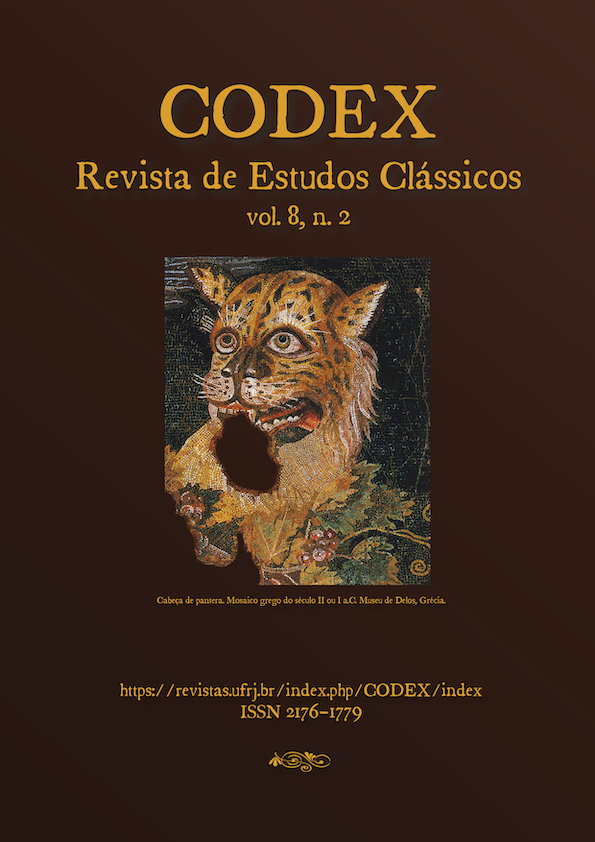Back from the Boulé: a short disquisition on "Knights" 611-755
DOI:
https://doi.org/10.25187/codex.v8i2.38229Keywords:
Aristophanes, Knights, syzygy, characterization, comedyAbstract
The syzygy of verses 611 to 755 prepares the Knights audience for the second and most important agón in the play, in which the sausage seller reencounters the Paphlagonian. This proagón shows that the sausage seller has already lost his innocence, becoming a competitor. In the play, however, there seem to be inconsistencies in the characterization of both the sausage seller and the Paphlagonian. The purpose of this article is, therefore, to propose a resolution for these apparent inconsistencies, outlining a coherent characterization option on the part of the playwright in relation to the boulé narrative and the collision in front of Demos’ house, thus explaining how it is possible for Aristophanes to maintain the two sections separate without sacrificing their blaming spirit and without using excessive repetition.
References
BROCK, R. The double plot in Aristophanes’ Knights. Greek, Roman & Bizantine Studies, n. 27, pp. 15-27, 1986.
BURNS, T. The political theory of Aristophanes: explorations in poetic wisdom. New York: State of New York University Press, 2014.
DOVER, K. J. Aristophanic comedy. Berkeley: UCP, 1972.
ENGLE, J. M. Playing about the stage: poetics, ritual, and demagoguery in the Knights of Aristophanes. PhD Dissertation in Classics. Princeton University, 1983. 190f.
FERGUSON, E. J. Costume change in Aristophanic comedy. M.A. Thesis. Athens, GA: University of Georgia, 2016. 62f.
MAJOR, W. E. The court of comedy: Aristophanes, rhetoric, and democracy in fifth-century Athens. Columbus: The Ohio State University Press, 2013.
MAZON, P. Essai sur la composition des comédies d’Aristophane. Paris: Hachette, 1904.
MCLEISH, K. The theater of Aristophanes. New York: Taplinger, 1980.
NEIL, R. A. (Ed.) The Knights of Aristophanes. Cambridge: CUP, 1901.
NEWIGER, H.-J. Metapher und Allegorie: Studien zu Aristophanes. München: C. H. Beck, 1957.
PARKER, D. Handout on Knights. Austin, TX: University of Texas at Austin, Oct. 8, 2001.
ROBSON, J. Whoring, gaping and hiding meat: the humour of male-on-male sexual insults in Aristophanes’ Knights. Archimèdes: Archéologie et Histoire Ancienne, n. 5, pp. 24-34, 2018.
SOCIETY, Athenian. Aristophanes: the eleven plays. New York: Loveright, 1943.
SPATZ, L. Aristophanes. Boston: Twayne, 1978.
VICKERS, M. J. Alcibiades on stage: Thesmophoriazusae and Helen. Historia: Zeitschrift für Alte Geschichte, v. 38, n. 1, pp. 41-65, 1989.
VICKERS, M. J. Pericles on stage: political comedy in Aristophanes’ early plays. Austin, TX: University of Texas Press, 1997.
WEERAKOON, U. The first demagogue of the western world as represented in old comedy: portrayal of Ceylon in Aristophanes. Journal of Humanities & Social Sciences, Kalyani, v. 30, pp. 135-161, 2015.
WHITMAN, C. H. Aristophanes and the comic hero. Cambridge: HUP, 1964.
WORMAN, N. Abusive mouths in Classical Athens. Cambridge: CUP, 2008.
Downloads
Published
How to Cite
Issue
Section
License
This work is licensed under a Creative Commons Attribution-NonCommercial 4.0 International License.










